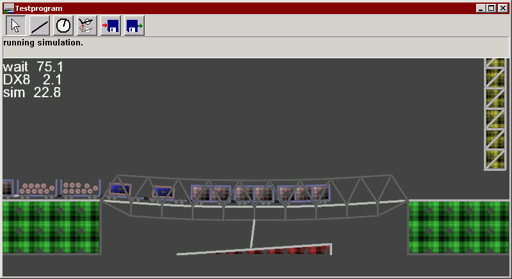|
|
Currently, only the core component of such a game is made - the physics simulation.
The simulation allows creating a 'world' out of only two components, bars and balls. Bars may be linked together to create larger structures, the links can be set stiff so they don't behave like hinges. The balls can be used to make something like gravel, or they can be attached to bars to make wheels. Using both, a train could be built and a bridge. See screenshots below.
The speed seems to be fast enough. The simulation in the screenshots below uses about 27% cpu time for simulation on my Athlon 750 system using 1000 steps per second. The step size could be increased some more if needed, but I believe that 500 steps per second is a minimum. Since moveing from GDI graphics to Direct3D, the time needed for graphics output shrumk from 30% to 3% and no longer steals too much time.
Until now, the testprogram slowly grew into a simple editor which could be used as a base for the game. It can add and remove bars, has cut/copy/paste functions and an undo buffer.
| testprog.zip | contains a windows sample executable (uses DirectX8) and PAK file. |
 The train is about to cross. The single bar in the middle adds the support needed. |
 The bridge collapsed. Only the engine itself made it across. |
 Somehow, the last three cars were lost here... |